As an Amazon Associate, I earn from qualifying purchases with no additional costs for you.
A wine aerator is a device that you place on the opening of your wine bottle before pouring the wine into a glass. While the wine is being poured, an air intake allows the wine to breathe instantly. Allowing the wine to breathe enhances its flavors.
Do wine aerators make a difference? Wine aerators make a difference for your wine by enhancing the flavor and aromas of your wine. With aeration, the sulfites and other compounds found in wine will evaporate and leave behind the flavorful compounds. This is an easier process than using a wine decanter.
Wine is something that people enjoy for many occasions – celebrations, relaxing, and over dinner. So, if it is possible to enhance its flavors, why wouldn’t you want to? Wine aerators can give your glass of wine extra oomph that will make your taste buds sore! Read on to find out how wine aerators work, how to use them correctly, and much more!

TIP: If you want to check out the best refrigerator for wine storage, I recommend trying out the Avation (18 bottles) compressor refrigerator with Wi-fi smart app control cooling system. You can find this refrigerator by clicking here (Amazon link).
How Wine Aerators Work
A wine aerator exposes the wine to the air. This exposure triggers two things – oxidation and evaporation.
- Oxidation is a chemical reaction that involves the moving of electrons.
- Evaporation is the process of a liquid turning into a vapor.
When wine is exposed to the air, the undesirable volatile compounds evaporate faster than the wanted compounds in wine. The compound sulfite is added to wine to help prevent oxidation, and this is one of the main compounds that become reduced with aeration.
Have you ever read a wine label that mentioned different aromas and notes the wine is supposed to have, but when you taste it, it just tastes like wine? An aerator allows the wine to breathe, which then exposes the undertones of the wine, adding a smoother finish.
The five main reasons people choose to use a wine aerator for their wine are:
- The chemical reactions in bottled wine can produce off-putting scents, so aeration helps reveal the good in the wine and exclude the bad gases.
- Aeration helps bring out the flavorful aromas in wines.
- It brings out all the flavors of wines.
- It helps soften more robust flavors.
- It is a much faster process than using a decanter, which could take at least 30-60
minutes.
Exposing wine to air is not as simple as opening up the cork to let it breathe. The narrow neck of a wine bottle does not allow enough oxygen into the wine to make it useful. Once your wine has been aerated, you will get a replica of the wine during its natural aging process.
Recommendation box: Everything you need to enjoy your wine as much as possible. All recommended products are personally tested and regularly used by experts from this website (Amazon links):
> Ivation Wine Cooler – Energy-efficient wine cooler for 18 bottles with Wi-fi smart app control cooling system.
> Wine Rack – Beautiful, elegant wood rack for up to 7 bottles and the choice of vertical or horizontal storage.
> Durand Wine Opener – Classic vintage wine opener (we like all these classic staff).
> YouYah Iceberg Wine Decanter – The most beautiful and handy wine decanter we personally use.
> Bormioli Rocco Wine Glasses – A set of eight elegant and traditional wine glasses made in Italy.
> Vintorio Wine Aerator – Simple but really useful wine aerator for a reasonable price.
> The Original Vacu Vin Wine Saver – The best wine saver on the market in a package with two vacuum stoppers and two wine servers.
And if you want to become a true connoisseur of wine, we recommend reading the book Wine Folly: The Essential Guide to Wine (Amazon link), where you will find all the information you need about winemaking, wine varieties, flavors, and much more.
How to Use a Wine Aerator
Before using a wine aerator, decide if you want your wine to be aerated. You can do this by pouring a small amount of the wine into a glass and giving it a small taste.
You then should swirl it around a few times to allow the wine to be exposed to the air and taste it again. Decide which you liked better, and then go ahead with your wine aerator.
Using a wine aerator is a natural process; you just insert it into the bottle and start pouring. There are a couple of different types of aerators you can choose from – the ones you place directly in the bottle and the ones that you pour the wine through into a glass.
Here are some examples of the wine aerators that do not get placed directly into the bottle (Amazon link):
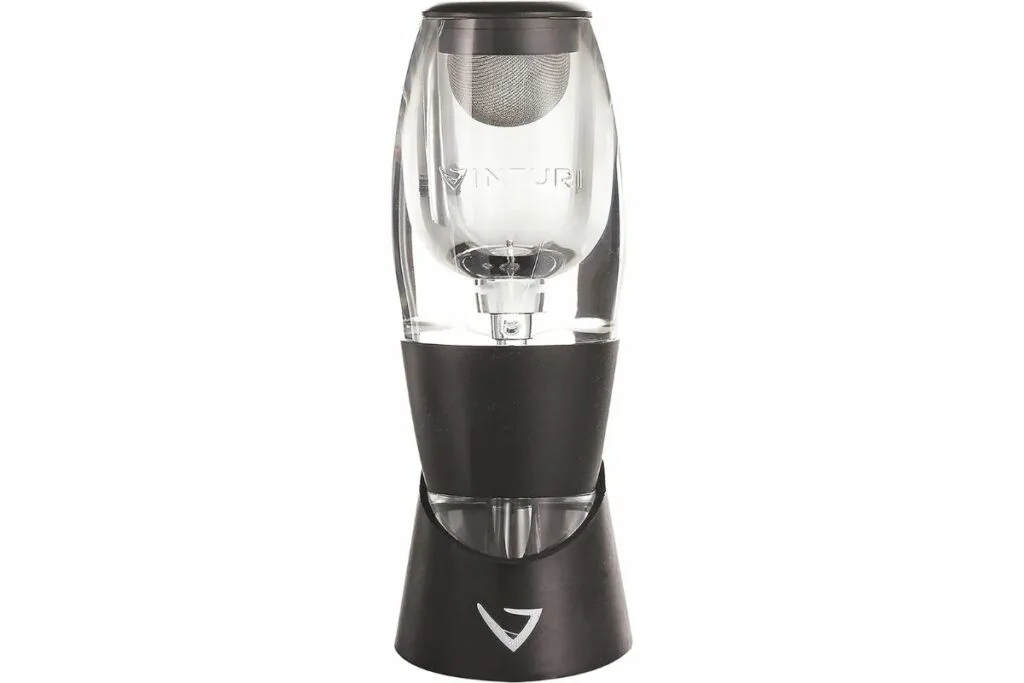
Vinturi Red Wine Aerator
- Vinturi V1010 – This is one you hold over your wine glass and pour the wine through.
- Vinturi V1071 – This is the same as the Vinturi V1010, but it comes with a stand that holds it in place while you only need to hold the bottle.
- Mafiti – This is a more affordable version that comes with a base and removable filter.
Here are some wine aerators that you easily place into the bottle and then pour away (Amazon links):
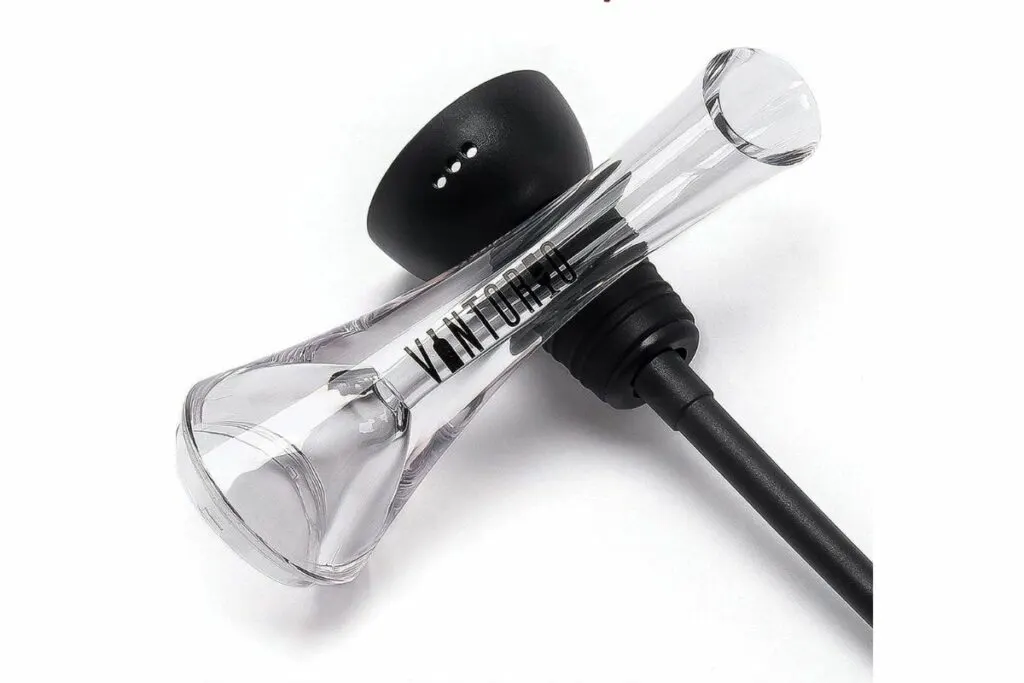
- Vintorio – This one comes with a rubber stopper that creates a leak-free seal for wine bottles of different sizes. The pour spout is ergonomically slanted to prevent dripping.
- TenTen labs – This is a two-pack for the price of one made of sturdy plastic with a silicon cap.
- Aervana Essentials electric wine aerator – This is a high-end aerator that allows you just to push a button to aerate your wine. This device provides six times the aeration as a regular aerator.
When using an aerator for the first time, you should sample the wine at different intervals so that you can figure out what is most desirable for you.
TIP: Should you use wine aerators on white wine? Find out here. How long does it take to decant wine? This guide has the answer.
Difference Between a Decanter and an Aerator
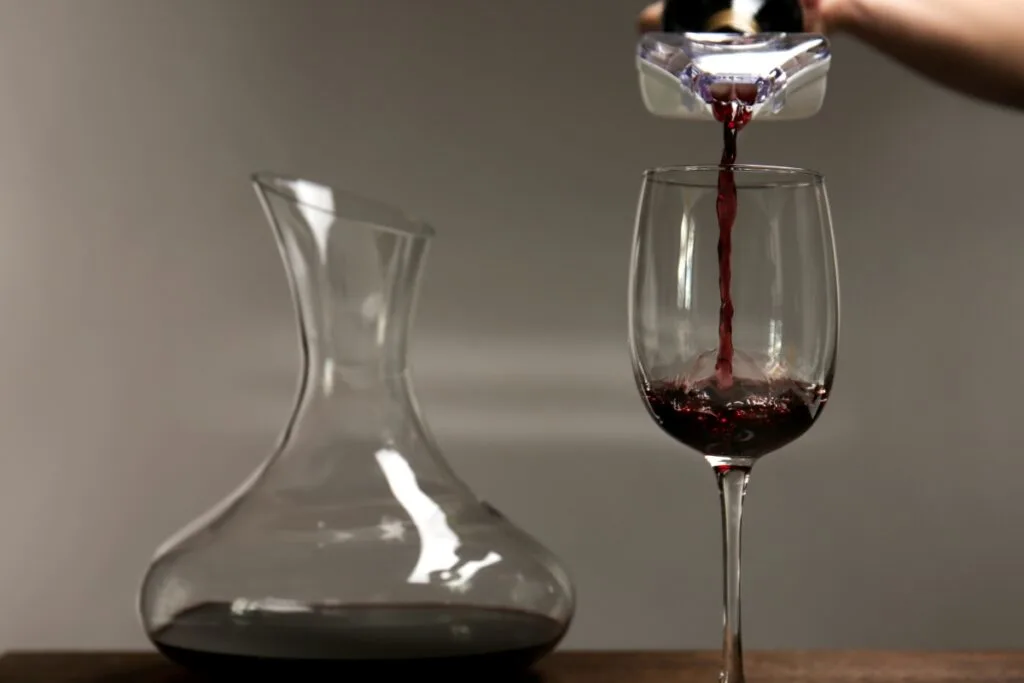
A wine decanter is a vessel that is used to hold wine for a few different reasons:
- To aerate the wine and enhance the flavor
- Separates sediment from liquid – Sediment collects at the bottom of the bottle and can have an unpleasant taste, a gritty texture, and an unappealing look.
- Saves the wine from a broken cork – If you get pieces of cork in your wine bottle, you can use a filter to pour the wine into a decanter without the cork.
Decanting wine can be a long process. If your bottle of wine has been lying on its side, you will want to have it upright for several hours before decanting. This is to allow all the sediment to collect at the bottom of the bottle. Once your wine is poured into the decanter, you should wait at least 30 minutes so that it has gone through the aeration process.
Therefore, the main difference between a decanter and an aerator is that decanting is a longer process, and the wine gets poured into a vessel rather than getting poured through a device.
TIP: If you are interested in buying a wine decanter, I recommend purchasing these two top-quality decanters:
- USBOQO Wine Decanter (check it out on Amazon & read customer reviews)
- Iceberg Wine Decanter (check it out on Amazon & read customer reviews)
Because decanters require a longer process, you’ll want to use an aerator for flavorful wine if you are on a time crunch – like if you have unexpected guests or you just need to crack open an unplanned bottle of wine. You and your guests will undoubtedly appreciate it.
If you don’t plan on going through an entire bottle of wine in one sitting, it would be best to use a wine aerator. Wine in a decanter will only last 2-3 days, any time after that may put off an unpleasant taste.
If it is an older bottle of wine and you did not finish it, you should pour it back into the bottle. When doing this, though, it is recommended to use a wine bottle vacuum pump to remove the air.
TIP: For a complete guide on how to clean an aerator and decanter in a dishwasher, check out this article. Discover the differences between a wine decanter and a carafe here.
Pros to Using a Decanter Over an Aerator
The idea of pouring a whole bottle of wine into a decanter is worrisome to some folks because of storage. Luckily, a great thing about decanters is that they can keep wine for 2-3 days.
So, if you’ve decanted a bottle of good wine and you are not able to finish it, it will still be good later. Decanting can help make your wine go down smoothly so that no wine will go to waste.
A big pro about a decanter is that they look classy. Seeing a red wine sitting in a beautifully shaped decanter is very aesthetically pleasing. Some nice ones are (Amazon links):
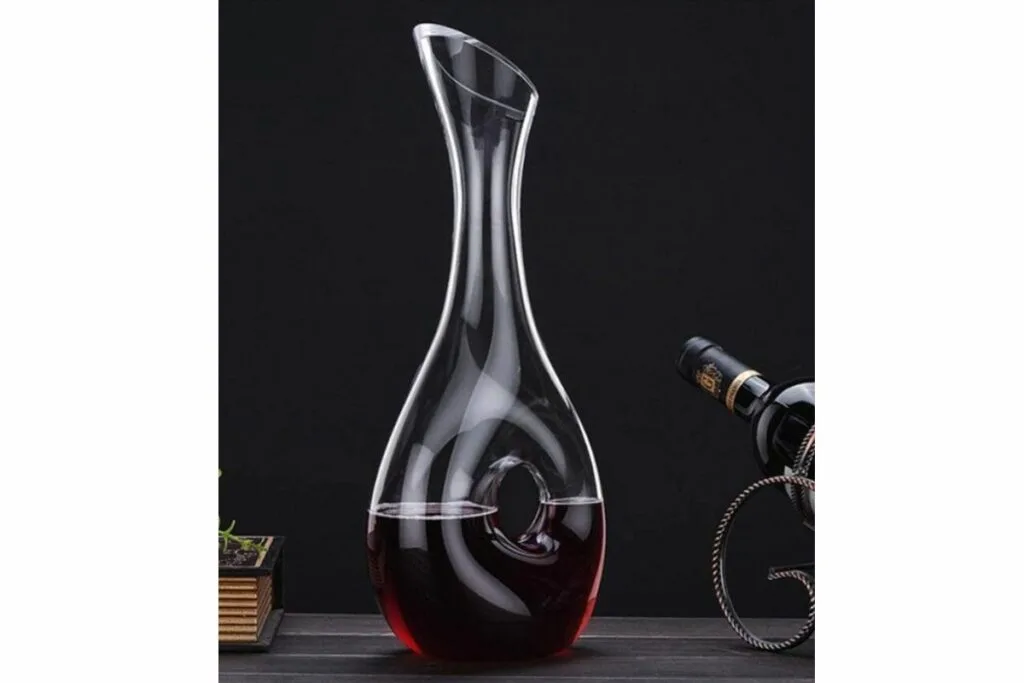
Another pro with decanters is that you can control the amount of air that is being exposed to the wine. With aerators, it gets poured through and always has the same amount of oxygen exposure. Some people like different amounts of air exposed to their wine.
Pros to Using an Aerator Over a Decanter
The number one pro of using an aerator is how fast it works. If you come home from work and randomly decide you would like a glass of wine, you can pop the aerator in and pour your wine instantly.
With an aerator, you do not have to worry about needing to finish your bottle of wine in one sitting so that it doesn’t go bad. You can either cork the bottle, or if your aerator has a rubber stopper, you do not even need to remove it to store your wine after opening and aerating it.
One thing with decanters is that it is recommended to have your bottle of wine sitting upright for a certain amount of time so that the sediment can settle.
You do not need to do this with an aerator; aerators typically have a filter that will help block anything that has settled in the bottle. This adds to the advantage of aerators being a grab-and-go process.
Which Wines Work Best for Each

Although you can use most wines in a decanter or an aerator, some wines do better in a decanter than they would an aerator. A good rule of thumb is that aerators do best with young, bold, and tannic red wines while decanters do best with older, more delicate bottles of wine.
Decanters do better with older wines because the older ones have more sediment in the bottle. Sediment is caused by fermentation and yeast and is not usually a big issue, but sometimes it has a harsh taste. It also has a bad mouth feel. It won’t hurt to drink it but it’s definitely not fun to drink.
Some higher-end aerators have filters that can filter this out, but it can sometimes clog the filter. So, it is good to have an aerator with a removable filter that can be washed.
When aerating wine, know that the younger it is, the more time it will need to breathe. Therefore, letting it breathe for about an hour will help soften the tannins. Aeration won’t increase the complexity of a younger wine, but it does soften and smooth out the flavors.
Older wines do better being aerated for a shorter amount of time. Over oxygenating an older wine can cause it to lose its flavors. They need only 10-15 minutes of air exposure to pull out their characters.
Which Wine Needs an Aerator and Which Do Not
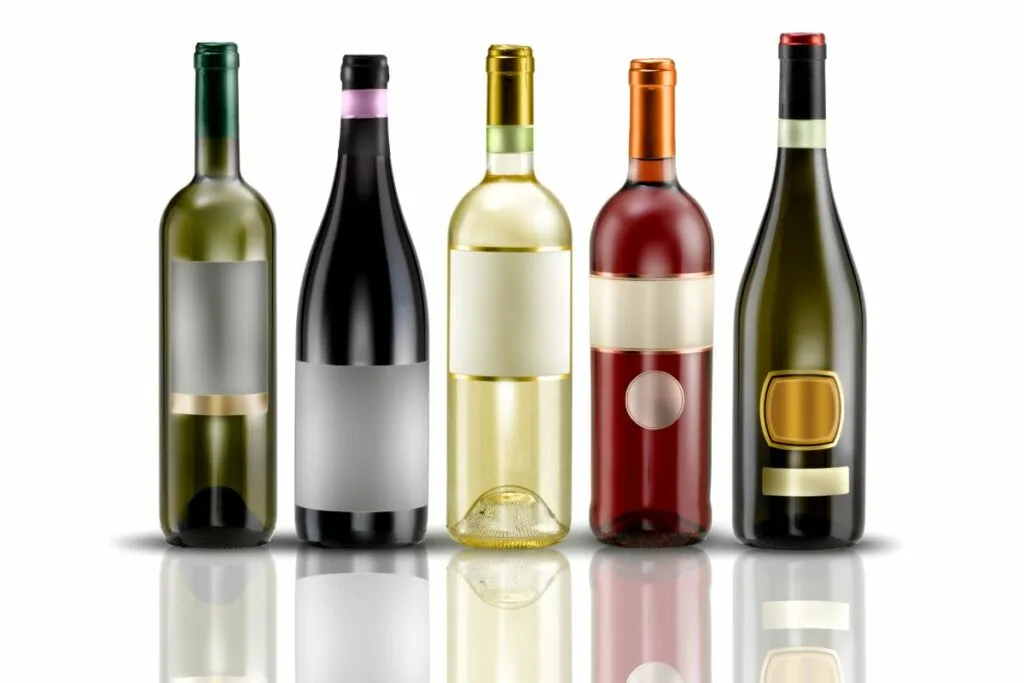
Typically, aerators are mostly used for red wines, but they can also be used for some white wines. The wines that you will get benefits from aerating are:
- Barbera
- Cabernet Sauvignon
- Bordeaux
- Montepulciano
- Vintage ports
Some white wines have traits of being dry and full-bodied, so these do well with aeration – like Corton-Charlemagne and Alsace wines.
These wines also do well in a decanter for 10-15 minutes. Heavy chardonnays can “open up“ through aeration, and whites that have been over-chilled will be better with some “room temperature air” being infused to them.
Some wines do not need to be aerated. Some wines can actually lose their flavors if exposed to air for too long. These are the light-bodied, less tannic reds. Some of them are:
- Pinot Noir
- Burgundy
- Beaujolais
- Cotes du Rhone
- Chiantis
- Dolcettos
Understanding Tannins
Younger wines are the most tannic. Tannins are the compound found in wine that gives it the not-so-friendly, mouth-drying effect. These tannins come from the stalk, seeds, and skin of the grapes used for red wines. The older the wine gets, the more tannins begin to fade out.
The number of tannins found in a grape will depend on several characteristics, like the type of grape that is being used and the climate that it grows in.
It sounds like tannins may be something you do not want in your wine, but there is an importance to them. Tannins help define the character and texture of the wine. Winemakers want to ensure that there are enough of the grape’s tannins extracted during processing to make sure the wine has character.
Along with building the wine’s character, the tannins work as a natural antioxidant that protects the wine.
Low & High Tannin Wines
Different wines have different ranges of tannins in them, and depending on your preference, you may prefer a low-tannin wine over a high-tannin one.
Wines that are low in tannins are known for their even-textured taste profile. These are the wines that are best for wine enthusiasts who are not a fan of dry wines.
Low-tannin wines are:
- Merlot
- Pinot Noir
- Zinfandel
High-tannin wines have a wide variety of textured taste profiles, and when they are paired with individual dishes, they can provide wine tasters with an even more exciting taste profile. These are the wines that do best in decanters, which look great on the table with delicious foods.
High-tannin wines are:
- Cabernet Sauvignon
- Nebbiolo
- Tannat
- Sangiovese
If you are prone to headaches after drinking wine, you most likely have a wine that is high in tannins. A downside of tannins is that they can cause headaches, so that is the culprit to your after-wine headache.
Other Ways to Aerate Wine
If you want to aerate your wine but do not have a decanter or aerator, luckily, there are a couple of other techniques you can try. Aerating is exposing the wine to the air, so all you must do is let it breathe.
One way is by swirling it in your glass. No, that isn’t just a thing wine drinkers do for no reason, they do have a method to their madness!
Swirling the wine in your glass allows for oxygen to reach it. But you should not just pour your wine to the rim and give it a nudge you’ll need to:
- Have a wine glass with a large bowl.
- Pour the wine to the broadest part of the glass.
- Let it sit for a while – younger wines are recommended to sit for about 40 minutes, and older wines should sit a shorter amount of time not to damage the fragile qualities.
- Give your wine a swirl and give it a taste.
If you do not want to wait that long for your wine to sit in the glass, you can pour less into the glass and swirl it right away. Having less makes it easier for the air to reach the wine.
TIP: A suitable wine glass is the basis for enjoying well-being while drinking your favorite wine variety. Here are our favorite ones (Amazon link):
- Bormioli Rocco Crystal Wine Glasses: A set of eight elegant and traditional wine glasses made in Italy for a reasonable price.
- Riedel VINUM Wine Glasses: Luxury set of two wine glasses suitable for any occasion. We just love them!
- Schott Zwiesel Tritan Crystal Glasses: If you like unusual alternatives, a set of six stemless glasses made of crystal glass.
Use a blender to aerate your wine. Many sommeliers recommend using a blender if you do not have a decanter. This is also a simple process, just pour the wine into the blender, close the lid, and let it rip for 20-30 seconds.
After blending your wine, you will notice the tiny bubbles that have formed at the top; this is a sign that the wine has been exposed to the air. You can drink your wine right after shutting the blender off.
Pouring wine into two pitchers is another common way to aerate your wine. If you do not have a pitcher, you can use a couple of glasses like mason jars.
You will want to pour some wine into one pitcher and then pour it from that pitcher into the other. Do this back and forth about 15 times to properly aerate the wine and drink it instantly.
TIP: For a few good ideas on how to decant wine without a decanter, read this guide. Do you need to know how many glasses of wine are in a carafe? This article explains how many glasses you can expect per carafe.
Conclusion
A wine aerator is used to expose the wine to air to draw out the flavors, aromas, and textures it holds. The great thing about aerators is that some attach directly to the bottle and instantly aerate the wine as you pour, allowing for instant aeration and delicious wine. Any wine enthusiast can tell you how much aeration can improve the taste of wine!
However, in the end, it is all about your preference. You can experiment with different wines to see if you like them better when they are aerated.
Doing this will also help improve your wine-tasting knowledge and help you pinpoint the different “notes” in the wine – notes refer to flavors and aromas in a glass of wine and how they come together.
TIP: Check out this page for a complete list of wine products and accessories I love. You’ll find my recommendations for wine refrigerators, decanters, and aerators and the best place to buy wine online. Click here to see the complete listing.
Sources:
http://norcalwine.com/blog/51-general-interest/157-do-wine-aerators-work-a-are-they-worth-the-money
https://www.starfrit.com/us/blog/why-use-a-wine-aerator?___from_store=en
